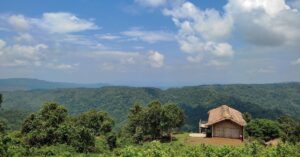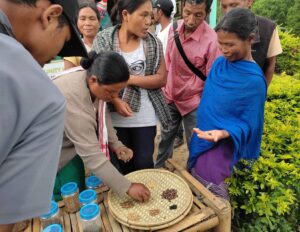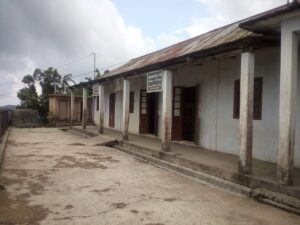Darechikgre community in West Garo Hills, Meghalaya, is an active participating village of NESFAS, where men, women and youth alike, acknowledge and uphold their duty as stewards of the land, and are rooted in tradition and respect for the same. The community is part of NESFAS’ project, “Protection of Forests in Meghalaya by adopting Participatory, Gender-Centric, and Equitable Approaches,” supported by The Nature Conservancy (TNC), and undertook a detailed documentation through the People’s Biodiversity Register (PBR).
During the project implementation, the community members shared tales of Rangdokram. Nestled in their village, Rangdokram is a place steeped in ancient reverence. Flowing beside it is the An·chengbok stream, a silent witness to the region’s spiritual history. Until the late 1980s, the people here adhered to their ancestral animistic beliefs. However, the 90s ushered in a shift, with Christianity taking root in the community.
An interesting legend surrounds Rangdokram. In the past, people from Williamnagar in East Garo Hills would travel to Tura on foot for the weekly markets. As they passed through a specific area within Darechikgre, they would hear sounds resembling music and dance. They envisioned the people of Darechikgre perpetually engaged in merrymaking, with the rhythmic beats of the rang– a traditional percussion instrument, and the lively Wangala dance filling the air. However, the truth was far more mysterious. It turned out that these were not the sounds of revelry, but those of spirits guarding the land. This very place came to be known as Mite Rangdokram- which can be literally translated to – the place where deities play their rangs
Rangdokram is considered sacred, and venturing onto the forbidden grounds is believed to bring illness or even death. Stones stand as silent sentinels, marking the spots where animistic rituals like Wachi Tata and Salak Tata were once performed. During times of drought, the kamal, or traditional priest, would beseech the rain gods through Wachi Tata, pleading for life-giving showers upon the parched land. Salak Tata, on the other hand, served as the counterpoint. When relentless rains threatened to flood the fields, the priest would perform this ceremony to implore the sun to return.
Bilnen B Marak, the headman of the village, recounts a story passed down through generations. “Our forefathers, Josengpa, Randokpa Balgan, and Watrepa Jingsang, were three brothers-in-law who went fishing in the lake at Rangdokram. Unexplainedly, they began to bleed from their heads, suffering a divine curse. This event serves as a stark reminder of the reverence we hold for this place. While people no longer strictly adhere to these ancient practices, having embraced Christianity, the respect for the spirits and the power of this sacred land endures.”
Determined to preserve the pristine character of Rangdokram, and Darechikgre as a whole, the community members have taken it upon themselves to safeguard the encompassing hillocks. They maintain the forest land meticulously and prohibit any encroachment.
Rajesh B Marak, a custodian farmer, stressed on the importance of sustainability of their surroundings saying, “We believe that our land is our treasure and we are its guardians. Therefore, we have to protect it by all means. As a community, we have to safeguard our forests, pass on these values to our children and grand-children so that they will also know the stories of the place they come from. We do not let anybody cut down trees from our forest reserves, or use the nearby areas to be turned into Jhum fields or other cultivation, as they may dry up our water bodies and kill aquatic life.”
The water supply to the main town of Tura originates from Rongkhon Dare which is in Darechikgre. They also have other water bodies, supplying drinking water to the neighbouring communities. This devotion to forest preservation also predates any intervention by external authorities. With water scarcity and exploitation of land and resources rampant everywhere, the people of Darechikgre continue to believe and serve as a testament of their commitment to sustainable practices.





